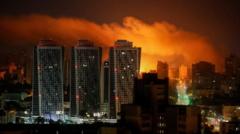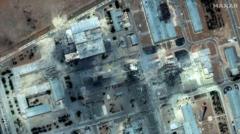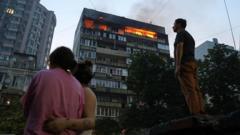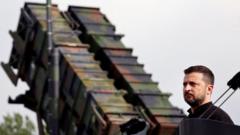As Russia intensifies its aerial assault with drones and missiles, Ukraine braves a new wave of coordinated strikes that disrupt daily life and heighten fears among civilians. Residents describe harrowing experiences during bombings, while military experts warn of the escalating toll on resources and defense capabilities.
Ukraine Faces Intensifying Drone Warfare as Russian Strikes Escalate

Ukraine Faces Intensifying Drone Warfare as Russian Strikes Escalate
The surge in Russian drone attacks is instilling fear across Ukrainian cities, threatening civilian morale and safety.
In the face of Russia's increasingly aggressive drone warfare, Ukrainian cities, including Kyiv, are witnessing a significant rise in fear and uncertainty. Recent months have seen a relentless wave of coordinated aerial attacks involving hundreds of drones and missiles targeting urban centers, a departure from the sporadic skirmishes of previous years.
Last night, Kyiv experienced its most intense bombardment since June, drawing comparisons to tactics reminiscent of World War II. The impact of these strikes reverberates through the civilian population, as many residents find themselves retreating to bomb shelters amidst the terrifying drone swarms. The air is filled with the sound of approaching missiles, forcing families to grapple with new levels of anxiety regarding their safety.
“Last night, the whole house shook,” recounted Katya, a resident of Kyiv, “We ended up huddled in the bathroom the entire night.” Her experience echoes that of many others who, for the first time since the war's early days, are returning to underground shelters during attacks—demonstrating a troubling shift in the Ukraine conflict as drones become the new standard for assault.
The aftermath of these strikes is staggering. Last month, the United Nations reported the highest civilian casualties in three years, including over 230 fatalities and more than 1,300 injuries, as missile and drone assaults rage across regions removed from the front lines. “The surge in long-range attacks is lethally impacting civilians well beyond immediate battle zones,” stated Danielle Bell, head of HRMMU, emphasizing the expanded reach of these deadly technologies.
Recent modifications to the Iranian-supplied Shahed drones allow them to fly higher and carry an increased payload, with ranges capable of reaching up to 2,500 kilometers. The complexity of Russian strategies also involves deploying decoy drones, which complicate Ukrainian air defenses and increase the likelihood of successful strikes.
Analysis indicates that Russia's drone and missile attacks have intensified, particularly following significant political events, contributing to new monthly records in destructive capability—with thousands of drones deployed in remarkably short time frames. Experts warn that this persistent onslaught could overwhelm Ukraine's defense systems if effective countermeasures are not developed soon.
“If Ukraine does not find a solution to combat these drones, we risk severe problems in the near future,” cautioned Ivan Stupak, a former intelligence officer. As Kyiv seeks to bolster its defense capabilities, President Zelensky has repeatedly appealed for greater international support to secure not only advanced missile systems but a broader array of aerial defense resources.
In response to these pressing needs, the British government has pledged to enhance Ukraine's air defense arsenal, signaling a commitment to countering the growing threat posed by Russian drone assaults. However, with the scale of opposition continuing to rise, Ukraine faces challenging prospects in maintaining its resilience against a significantly resource-driven adversary.






















